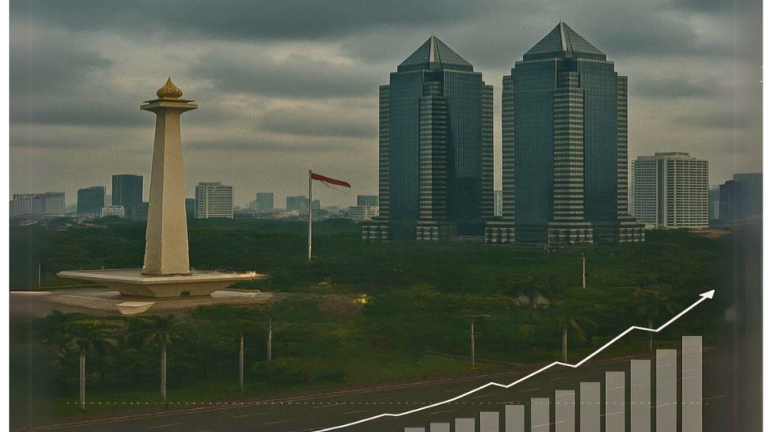The current economic situation in Indonesia, characterised by a lack of decent-paying jobs and the serious problem of cost of living, has left many young Indonesians hopeless over their future in the country.
This situation has triggered massive recent demonstrations against the government by students and the youth in Jakarta and other major cities. Whether it will lead to profound social and political upheaval as per nearly thirty years ago is still debatable.
In 1998, Indonesia experienced gripping social turmoil. Riots in Jakarta took place that cost many lives. Most of the violence was directed towards the Chinese-Indonesian community. Their businesses and houses were burned down, and many had to seek refuge in Singapore.
This crisis severely undermined the legitimacy of President Suharto, who had ruled Indonesia for over 30 years under his authoritarian New Order regime. Public protests led by students and civil society groups demanded political reform and Suharto’s resignation.
On 21 May 1998, following massive protests and withdrawal of support by key political figures and the military, Suharto resigned and handed power over to his deputy B.J. Habibie.
So then, what was the leading cause of the crisis? The real answer: debt. In the early 1990s, Indonesia experienced rapid GDP growth (averaging 7% annually). However, this growth was built on expedient debt accumulation in both public and private sectors, but especially the latter.
Privately owned corporations borrowed heavily in foreign currencies (mainly USD) to exploit lower interest rates abroad. By 1997, private external debt reached USD80 billion whereas government debt totalled USD55 billion.
The Indonesian central bank pursued a policy of pegging the rupiah to a basket of currencies, creating an illusion of stability. In reality, though, it was overvalued and prone to depreciation should there have been a crisis of confidence in the Indonesian economy.
Additional factors included the weakness of institutions needed to ensure efficiency in utilising economic resources. Corruption and crony capitalism were rampant under President Suharto’s 32-year authoritarian rule (1967–1998).
Many monopolies were run by business people connected to Suharto and his close family members. These businesses could not only charge their customers high prices due to lack of competition, but they could also avoid paying the Indonesian government taxes. Subsidised loans were also given to politically connected businesses.
The banks found it difficult to refuse to lend money to firms run by Suharto’s cronies. In other words, financial oversight became very weak in Indonesia due to this crony-based business environment.
All the above factors left Indonesia’s economy standing on very brittle foundations, poised to suffer a crisis were circumstances to change. Unfortunately, this was exactly what happened following regional economic collapse in 1997.
The other countries involved had also experienced economic growth based on borrowed USD and hot money that flowed into the stock market. The worst-hit was Thailand, which experienced its first crisis of confidence when speculators felt that the Thai baht was also overvalued due to its imports outweighing its exports. Massive short-selling of the Thai baht caused it to collapse in July 1997, triggering investor panic across Southeast Asia.
Financial speculators then targeted Indonesia’s frail economic system. The rupiah plunged from 2,500 IDR/USD in July 1997 to 16,800 IDR/USD in June 1998, a 670% depreciation. Indonesian corporations with USD-denominated loans suddenly faced insurmountable repayment costs.
Many defaulted, thus crippling banks that had lent to them and causing a collapse of the banking sector. Over 80% of Indonesian banks were technically insolvent by late 1997 due to the failure of their local corporation borrowers to repay USD debts following the rupiah’s collapse.
Moreover, the problem of bank runs arose when the panicking public started to withdraw their deposits, leading to drained liquidity in the banks.
Faced with the imminent collapse of the Indonesian economy, Suharto sought financial assistance from the IMF; Indonesia asked for a USD43 billion bailout in October 1997.
However, as with all IMF assistance programs, stringent conditions were imposed, which included a tight monetary policy (the central bank of Indonesia was forced to implement high interest rates to stabilise the rupiah) as well as fiscal austerity (the government slashed subsidies for fuel and food).
Unfortunately, these policies exacerbated the situation further. The poverty rate doubled from 11% in 1996 to over 20% by 1999. Unemployment also increased, and many businesses collapsed due to the high interest rates.
These constituted the background to the deadly riots and the political upheaval that ensued, ultimately leading to Suharto handing over political control to his deputy, B.J. Habibie. In other words, the Indonesian economic growth of the early and mid-1990s was unnatural and unsustainable because it was fueled by debt.
Therefore, the most important lesson that should have been learned by Indonesia was eschewing the debt-based economic development model. Another important takeaway was to eliminate the rampant corrupt practices in Indonesian society.
However, Indonesian leaders and policymakers failed to learn from these harsh lessons, especially the dangers of debt-based economic development. The Jokowi government continued to borrow money to spend on projects in spurring economic growth.
The private sector similarly engaged in massive borrowings to expand its operations. The expansion was based on the optimistic perception of the business situation in Indonesia. It did not help that Sri Mulyani Indrawati, the finance minister, was an ex-IMF staff. Her prescription for the economy followed the typical Western-trained economist model where debt-based economic growth is considered inevitable.
These economists will not deviate from the mantra that a debt-based economy can still flourish provided the debts are channelled to productive sectors for the economy’s benefit, seemingly oblivious to the fact that when a debt-for-profit industry is allowed to exist and grow, a pattern of temporary growth followed by a devastating crash is certain, as proven by scores of financial crises in the past.
Therefore, it is unsurprising that the Indonesian economy is again facing tough times after a period of economic growth during the last few years. It does not help that there has been an unfavourable business climate globally in recent years, including the risk of a soon-to-come recession in the US.
As a result, many companies are experiencing financial difficulties, especially those carrying heavy debt burdens which force them to get rid of tens of thousands of workers.
According to news reports by the Labour Party and the Indonesian Workers’ Confederation (KSPI), mass layoffs affected more than 60,000 workers across 50 companies in Indonesia between January and February 2025.
KSPI President Said Iqbal said its research has indicated that 30 percent of these companies (including the renowned textile firm Sritex) have gone bankrupt, emphasising the widespread nature of the problem. He noted that the layoffs have primarily affected textiles, garments, footwear, electronics, automotive, and other labour-intensive sectors.
Over 21,000 workers have been made redundant at companies, including PT Karya Mitra Budi Sentosa, which has laid off 10,000 employees, and PT Danbi Internasional, PT New Era, and PT Yihong Novatex, each of which has shed 2,000 jobs.
Other companies, such as PT Aditec Cakrawityata, PT Duta Cepat Pakar Perkasa, and PT Dupantex have also made significant job cuts affecting 500 to 1,500 workers.
The current poor performance of the Indonesian economy over the last few months, the lack of jobs, and the high cost of living have left many young Indonesians hopeless. Consequently, they are channeling their dissatisfaction towards the new government under Prabowo Subianto.
In February of this year, thousands of students staged ‘Dark Indonesia’ protests nationwide. Issues that upset them include budget cuts and other Subianto policies perceived as not in the best long-term interests of the country.
They are demanding the immediate repeal of the presidential instruction issued on 22 January of this year, which mandates cuts of 306.7 trillion rupiah (USD 18 billion) in government spending, measures they have condemned as “rushed and detrimental” and feared to undermine social support systems and their futures.
Unfortunately, most of these protestors are unaware that if the government does not implement budget cuts and continues to px ursue debt-based economic growth, unemployment problems and the cost of living will only worsen in the long run. There is not much the government can do.
Alas, many political leaders are fond of making promises of future economic prosperity when in power to secure political support. They should realise by now that those promises will come back to haunt them when they cannot deliver on them, especially when the root cause of the problem is not addressed.
Prof Emeritus Dr Mohd Nazari Ismail
Faculty of Business and Economics
Universiti Malaya
26 March 2025







